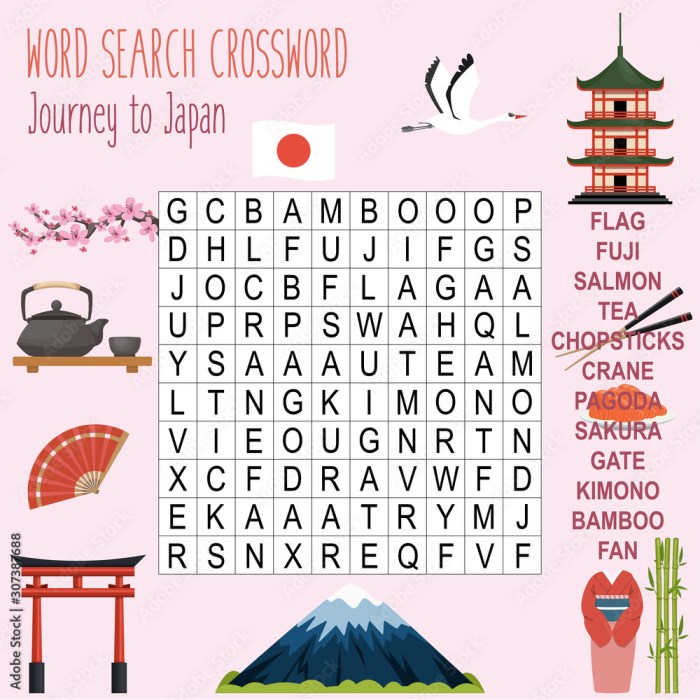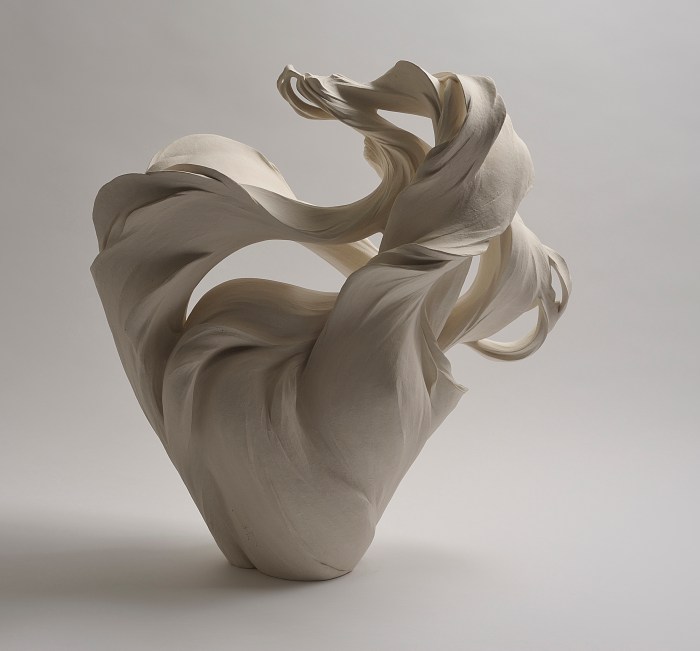Art form from japan crossword invites you on an exciting journey into the realm of Japanese culture and creativity. This captivating crossword puzzle not only challenges your knowledge but also offers a fascinating glimpse into the rich tapestry of Japanese art forms.
From the delicate brushstrokes of traditional calligraphy to the intricate patterns of kimono textiles, art form from japan crossword unveils the beauty and diversity of Japanese aesthetics.
Japanese Art Forms

Japanese art forms have a rich and diverse history, deeply rooted in the country’s culture and traditions. These forms encompass a wide range of artistic expressions, from traditional painting and calligraphy to contemporary installations and digital art.
The origins of Japanese art can be traced back to ancient times, with influences from China, Korea, and other Asian cultures. Over centuries, Japanese artists have developed unique styles and techniques that reflect the country’s distinct aesthetic sensibilities.
Painting, Art form from japan crossword
Japanese painting has a long and illustrious history, dating back to the Asuka period (538-710 AD). Early paintings were heavily influenced by Chinese and Korean styles, but over time, Japanese artists developed their own unique techniques and subjects.
- Yamato-e: A style of painting that emerged in the Heian period (794-1185 AD), characterized by its use of bright colors and flowing lines to depict scenes from Japanese literature and history.
- Ukiyo-e: A genre of woodblock prints that flourished in the Edo period (1603-1868 AD), depicting everyday life, landscapes, and historical events.
- Nihonga: A modern style of painting that emerged in the late 19th century, combining traditional Japanese techniques with Western influences.
Traditional Japanese Crafts

Traditional Japanese crafts encompass a wide range of artistic practices that have been passed down through generations. These crafts reflect the unique aesthetics and cultural values of Japan, showcasing the country’s rich artistic heritage.
The diversity of Japanese crafts is vast, encompassing ceramics, lacquerware, textiles, metalwork, and woodwork. Each craft has its own distinct techniques and materials, contributing to the diverse expressions of Japanese artistry.
Ceramics
Japanese ceramics are renowned for their exquisite craftsmanship and delicate beauty. Potters employ various techniques, including wheel-throwing, hand-building, and glazing, to create a wide range of ceramic wares. Japanese ceramics often feature intricate patterns, vibrant colors, and a distinctive simplicity that reflects the country’s minimalist aesthetic.
Lacquerware
Japanese lacquerware involves the application of multiple layers of lacquer, a natural resin derived from the sap of the lacquer tree, onto various surfaces. Lacquerware is known for its durability, resistance to moisture, and its ability to create intricate and decorative designs.
The technique has been used to create a variety of objects, from bowls and plates to furniture and musical instruments.
Textiles
Japanese textiles are renowned for their exceptional quality and craftsmanship. Silk, cotton, and hemp are among the most commonly used materials, and weavers employ various techniques to create a wide range of fabrics. Japanese textiles are often characterized by their vibrant colors, intricate patterns, and a refined sense of elegance.
Modern and Contemporary Japanese Art
The 20th and 21st centuries witnessed a transformative evolution in Japanese art, characterized by a dynamic interplay between tradition and innovation. Japanese artists embraced Western influences while simultaneously exploring their own unique cultural heritage, resulting in a vibrant and multifaceted artistic landscape.
Impact of Western Influences and Globalization
The Meiji Restoration in the late 19th century opened Japan to the outside world, exposing Japanese artists to Western art and techniques. This exposure had a profound impact on Japanese art, leading to the adoption of oil painting, perspective, and other Western conventions.
However, Japanese artists did not simply imitate Western art; they skillfully adapted and integrated these influences into their own distinct artistic style.
Globalization in the late 20th and early 21st centuries further accelerated the exchange of ideas and artistic practices between Japan and the rest of the world. Japanese artists traveled abroad, participated in international exhibitions, and collaborated with artists from diverse cultures, leading to a cross-pollination of artistic styles and perspectives.
Innovative and Experimental Works
Contemporary Japanese art is characterized by a remarkable diversity of styles and mediums. Artists are pushing the boundaries of traditional art forms and experimenting with new technologies and materials. Some notable examples include:
- Yayoi Kusama: Known for her immersive installations featuring polka dots, infinity mirrors, and pumpkins.
- Tatsuo Miyajima: Explores themes of time and technology through his LED installations and digital sculptures.
- Mariko Mori: Creates interactive installations that combine photography, video, and sound to explore identity and the relationship between humans and technology.
Japanese Architecture and Design
Japanese architecture and design are renowned for their unique blend of traditional aesthetics and modern functionality. The principles of Japanese architecture emphasize harmony with nature, simplicity, and functionality, creating structures that are both visually appealing and practical.
Use of Natural Materials
Japanese architecture heavily utilizes natural materials such as wood, stone, and paper. These materials create a sense of warmth and connection to the surrounding environment. Wood is used for structural elements, flooring, and decorative features, while stone is often used for foundations and exterior walls.
Paper is used for sliding doors, screens, and even as a building material in the form of tatami mats.
Japanese Performing Arts
Japanese performing arts encompass a diverse range of traditional and contemporary art forms that reflect the country’s rich cultural heritage. These art forms include theater, music, and dance, each with its unique characteristics and historical significance.
Theater
Japanese theater has a long and celebrated history, dating back to the 7th century. It is known for its stylized performances, elaborate costumes, and traditional music. Noh theater, a form of classical theater that originated in the 14th century, is characterized by its slow, deliberate movements, symbolic gestures, and poetic language.
An art form from Japan is a crossword that can be challenging to solve. If you find yourself struggling, you might want to agree with a plan to tackle the puzzle. Once you’ve solved it, you’ll feel a sense of accomplishment.
It’s like completing a puzzle, but with words.
Kabuki theater, a more popular form of theater that emerged in the 17th century, is known for its dynamic action, colorful costumes, and exaggerated makeup.
Music
Japanese music is as diverse as its performing arts, ranging from traditional folk songs to modern pop and rock. Traditional Japanese music instruments include the shamisen (a three-stringed lute), the koto (a 13-stringed zither), and the shakuhachi (a bamboo flute).
Gagaku, a form of court music that dates back to the 6th century, is known for its complex arrangements and elegant melodies. Enka, a popular genre of Japanese music that emerged in the 1950s, is characterized by its sentimental lyrics and emotional delivery.
Dance
Japanese dance is an integral part of the country’s performing arts tradition. Traditional Japanese dances include the elegant and graceful movements of Nihon buyo, the dynamic and athletic performance of Yosakoi, and the ritualistic dances of Kagura. Contemporary Japanese dance has emerged in recent decades, incorporating elements from both traditional and Western dance forms.
Japanese Visual Arts

Japanese visual arts encompass a wide range of traditional and contemporary forms, each reflecting the unique aesthetic and cultural values of Japan. From the delicate brushstrokes of calligraphy to the vibrant colors of woodblock prints, Japanese visual arts have captivated audiences worldwide.
Painting, calligraphy, and photography are among the most prominent forms of Japanese visual arts. Traditional Japanese painting techniques emphasize the use of natural materials, such as ink, watercolor, and pigments derived from plants and minerals. Calligraphy, considered a high art form in Japan, involves the expressive writing of characters using a brush and ink.
Photography, introduced to Japan in the 19th century, has since flourished as a medium for capturing the beauty and diversity of Japanese culture and landscape.
Painting, Art form from japan crossword
Japanese painting encompasses various styles and techniques, including ink wash painting, known as sumi-e, and the colorful and decorative style of ukiyo-e woodblock prints. Sum-e painting, characterized by its simplicity and elegance, uses black ink and a brush to create subtle gradations of tone and texture.
Ukiyo-e prints, popular in the Edo period (1603-1868), depict scenes from everyday life, landscapes, and portraits of actors and courtesans.
Calligraphy
Japanese calligraphy, known as shodo, is a highly respected art form that combines the beauty of written characters with the expressive brushstrokes of the artist. Calligraphy is often used in traditional Japanese arts, such as poetry, scrolls, and decorative objects.
The practice of calligraphy requires years of training and mastery of brush techniques and ink control.
Photography
Japanese photography has a rich history and has produced renowned photographers such as Nobuyoshi Araki and Daido Moriyama. Japanese photographers are known for their innovative use of light, composition, and perspective, capturing the essence of Japanese culture and society. Contemporary Japanese photography continues to push boundaries, exploring themes of identity, memory, and the relationship between humans and the environment.
Japanese Fashion and Textiles
Japanese fashion and textiles have a rich and storied history, with influences ranging from ancient traditions to modern global trends. Traditional Japanese clothing, such as the kimono and obi, is known for its elegance and intricate designs. In recent decades, Japanese fashion has gained international recognition for its innovative and avant-garde styles.
History and Evolution
The history of Japanese fashion can be traced back to the Jomon period (14,000-300 BCE), when people wore simple garments made from animal skins and plant fibers. During the Heian period (794-1185 CE), the kimono emerged as the standard attire for both men and women.
The kimono is a long, flowing robe with wide sleeves, and it is often decorated with elaborate patterns and designs.The Meiji period (1868-1912 CE) saw a significant change in Japanese fashion, as the country began to adopt Western influences. Western-style clothing became popular among the elite, while traditional Japanese clothing continued to be worn by the general population.
In the 20th century, Japanese fashion began to emerge as a distinct style, with designers such as Issey Miyake and Yohji Yamamoto gaining international recognition.
Traditional Fabrics
Traditional Japanese fabrics are known for their beauty and craftsmanship. Some of the most well-known fabrics include:
- Kimono: A long, flowing robe worn by both men and women. Kimonos are typically made from silk and are often decorated with elaborate patterns and designs.
- Obi: A wide sash worn around the waist of a kimono. Obis are typically made from silk and are often decorated with intricate designs.
- Yukata: A lightweight cotton kimono worn during the summer months.
- Haori: A short jacket worn over a kimono.
Influence on International Trends
Japanese fashion has had a significant influence on international trends. In the 1980s, Japanese designers such as Issey Miyake and Yohji Yamamoto gained international recognition for their innovative and avant-garde styles. These designers used traditional Japanese fabrics and techniques to create clothing that was both modern and timeless.In
recent years, Japanese fashion has continued to influence international trends. Japanese designers such as Rei Kawakubo and Junya Watanabe are known for their experimental and conceptual designs. These designers have challenged traditional notions of beauty and fashion, and their work has been influential in shaping the way that we think about clothing.
Japanese Cuisine as an Art Form
Japanese cuisine is not merely a means of sustenance but an elevated art form that embodies the nation’s rich cultural heritage. The culinary traditions and techniques employed in Japanese cooking elevate it to the realm of an art, with meticulous attention to fresh ingredients, exquisite presentation, and profound symbolism.
Culinary Traditions and Techniques
Japanese cuisine is renowned for its emphasis on seasonality, utilizing the freshest ingredients available at each time of the year. Chefs strive to preserve the natural flavors of these ingredients through minimalist cooking methods such as steaming, grilling, and simmering.
The concept of “umami,” the fifth taste, is central to Japanese cooking, achieved through the combination of various ingredients and fermentation techniques.
Presentation and Symbolism
The presentation of Japanese dishes is an integral part of the culinary experience. Chefs arrange food on plates with meticulous precision, creating visually stunning compositions that enhance the flavors. Every element, from the shape of the plate to the placement of each ingredient, carries symbolic meaning.
For example, round plates represent harmony, while square plates symbolize stability.
Influence on International Gastronomy
Japanese cuisine has had a profound influence on international gastronomy, inspiring chefs worldwide. Its focus on fresh ingredients, minimalist techniques, and umami-rich flavors has revolutionized the culinary landscape. Japanese dishes such as sushi, ramen, and tempura have become beloved staples in many cultures, while Japanese cooking techniques have been incorporated into various cuisines.
FAQ Section: Art Form From Japan Crossword
What is the significance of art form from japan crossword?
Art form from japan crossword serves as an educational and entertaining tool that introduces players to the diverse art forms of Japan.
How can I solve art form from japan crossword?
To solve the crossword, players must use their knowledge of Japanese art and culture to fill in the blanks with the correct answers.
What are some of the unique features of art form from japan crossword?
Art form from japan crossword incorporates traditional Japanese aesthetics and symbolism into its design, making it a visually captivating and culturally enriching experience.